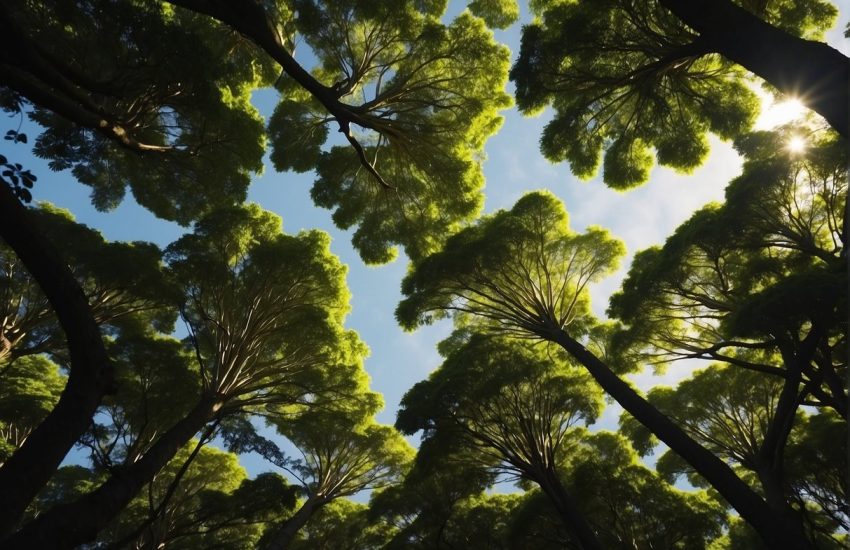The Best Magnolia Trees to Grow in Virginia
Magnolia thrives in Hardiness Zones five through eight. Thus, it’s a perfect fit for Virginia! We’ve compiled a list of the best magnolia trees for Old Dominion landscapes. Follow our tips and tricks to be sure your favorite flowering trees thrive in your yard!
Sweetbay Magnolia (Magnolia virginiana)
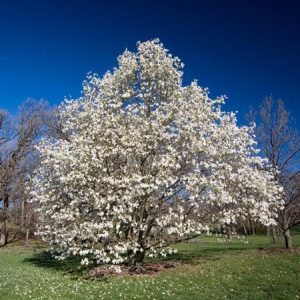
Sweetbay is one of the only Magnolia varieties that’s native to Virginia. It is sometimes referred to as swamp magnolia. European colonists called it ‘beaver tree,’ as they used it to bait these semi-aquatic rodents.
This ornamental tree produces lily-like white flowers and small, thin leaves. The bark is a silvery gray color. This lovely tree can grow to be anywhere from 20 to 60 feet tall. Its flowers bloom as early as April. Each bloom only lasts for three to four days. However, a single tree can stay in bloom for as long as two months. Each flower has nine to 12 tepals arranged in a semisphere. The blossoms produce a fruity, flora aroma. The blossoms close each night and reopen in the morning. The plant’s fruit is typically ready by October. The cone-shaped fruits contain several red seeds. These can be saved and planted.
According to local arborists, sweetbay grows best in Virginia’s Coastal Plain and Piedmont Regions. It thrives in the swamps and wetlands along the Mid-Atlantic and Gulf coasts. Sweetbay loves soggy, moist soil. These consolidated trees also do well in small yards and urban areas.
Common sweetbay varieties include Henry Hicks, moonglow, emerald tower, and keltyk. Keep in mind that it can take years for an immature sweetbay tree to grow flowers. This resilient magnolia variety can be propagated from seed or cutting. There’s no need to rush things! These lovely trees can live to be 80 years old.
Umbrella Leaf Magnolia (Magnolia tripetela)
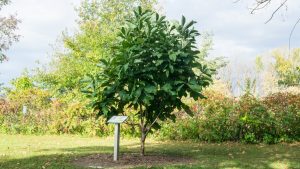
Umbrella leaf magnolia is a decorative plant that’s native to the southeastern United States. The tree produces large clusters of elongated green leaves, star-shaped flowers, and cone-shaped fruits. The tree’s impressive leaves grow in clusters located at the ends of its branches. The luscious whorls look like emerald green umbrellas. The flowers are white and can be anywhere from 6 to 10 inches in diameter. Most have between six and 12 tepals. The shrub-like tree tends to have multiple gray trunks.
Cucumber Tree Magnolia (Magnolia acuminata)
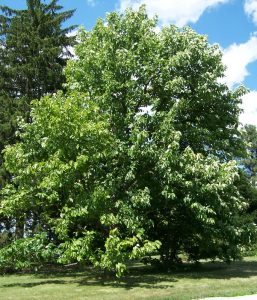
Cucumber tree magnolia is a hearty deciduous plant that can grow to be 60 to 75 feet in height. It produces green-white flowers and cucumber-like fruits.
The cucumber tree magnolia grows wild in parts of Canada. It is also planted throughout many parts of the United States. The plant prefers direct sunlight and moist soil. Mature cucumber-tree magnolias are quite large. Therefore, they should only be propagated in spaces that allow for plenty of outward and upward growth.
Cucumber trees are some of the largest members of the magnolia family. They’re also cold- and drought-resistant. It’s one of only a handful of magnolia varieties that are preferred for their foliage rather than their flowers.
White Flowering Star Magnolia (Magnolia stellata)
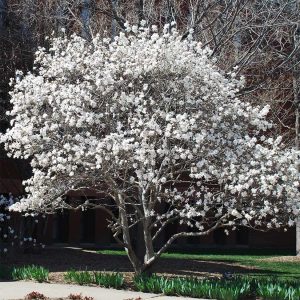
This non-native Magnolia variety is often utilized by landscapers and professional gardeners. It produces a stunning canopy of fuzzy white buds that eventually open to become small white flowers with pale pink centers. The spectacular floral displays last for only a few weeks. The fleeting blooms quickly make way for large oblong leaves. By late summer, the plant yields large fruits. These plants typically grow to be quite short and bushy and have several dominant trunks. At just 15 feet or so, white star magnolias seem more like shrubs than trees. However, they will sprout up when given the opportunities to do so.
White flowering star magnolia originates from the Japanese Island of Honshu. It was introduced to the United States in the 1860s. It’s sometimes referred to as ‘Jane Platt.’
Pink and White Blooming Saucer Magnolia (Magnolia × soulangeana)
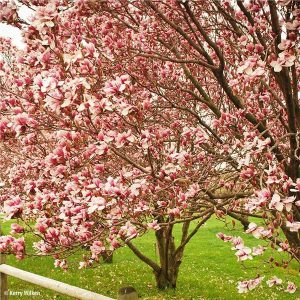
Pink and white blooming saucer magnolia is another non-native magnolia variety that takes well to Virginia’s semi-tropical climate. This incredible species produces 5- to 10-inch flowers. The blooms appear in early spring and are a favorite of pollinators. When the blossoms fade, the tree produces large green leaves. These last throughout the greater part of Virginia summers. Their appearance is followed by the emergence of the plant’s conical red fruits.
This fast-growing tree does well in a wide variety of environments. Like most other magnolia trees, it prefers moist, well-draining soil and full sun. The pink-and-white saucer plant can grow to be 30 feet tall. Meanwhile, its canopy can be upwards of 25 feet in diameter.
The saucer magnolia thrives in Hardiness Zones four through nine. It’s likely to grow even taller in warmer regions.
Southern Magnolia (Magnoalia grandiflora)
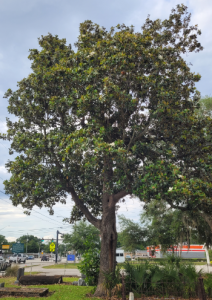
Southern magnolia, or ‘bull bay,’ is another magnolia that’s native to the southeastern part of the country. This impressive tree grows in forests from Virginia to Florida. The trees produce cream-colored flowers with delicate yellow stamens. The substantial blooms can be as big as 12 inches in diameter. The impressive flowers last from late spring to early summer. Their presence is accompanied by a strong but agreeable fragrance. The leaves of this tree are shiny and dark green with reddish-green underbellies. The tree produces large pod-like clusters of seeds each fall.
The southern magnolia can grow to be up to 80 feet tall and 40 feet wide. It can add grow up to a foot in a single year so long it is planted in ideal conditions. Southern magnolias prefer well-draining soil and partial shade.
There are several varieties of the southern magnolia. Our favorites include Alta, Bracken’s brown beauty, Edith bogue, and D.D. Blanchard.
Bigleaf Magnolia (Magnolia macrophylla)

The bigleaf magnolia possesses the largest leaves of all the trees that are native to North America. Its oblong green foliage can grow to be 30 inches long. They produce a dense, rounded canopy. The bigleaf magnolia also produces exceptionally large flowers. The fragrant blossoms are pink and purple. They’re often concealed by the tree’s extensive canopy. The flowers fade away and give way to cone-shaped fruits that are laden with red seeds.
The bigleaf magnolia grows wild throughout the southeastern United States. They can be propagated. However, their large leaves make them uncommon landscaping elements. This impressive tree cannot tolerate extreme heat, moisture, or pollution. It also needs to be protected from strong winds and extreme cold.
Ashe magnolia is a close relative of the bigleaf. It can grow to be 40 feet tall with a canopy that’s 30 feet wide. Other close relatives include the Mexican bigleaf magnolia and the cloud forest magnolia. Both of these trees produce leaves that are 1 to 2 feet in length.
Sargent’s Magnolia (Magnolia sargentiana)
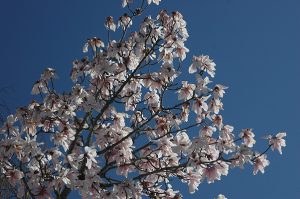
Sargent magnolia is a flowering tree that’s native to China and can be found growing wild in the forests of the Szechwan Province. It can take on a shrub-like appearance or grow to be upwards of 65 feet tall. It also produces exceptionally large flowers and shiny green leaves. Its flowers are pink on the outside and white on the inside. Each has 16 tepals and a sweet-smelling aroma.
It takes roughly 10 years for a seedling to bloom. The flowers appear in late spring. Meanwhile, the fruit appears in late summer or early fall.
Kobus Magnolia (Magnolia kobus)

Kobus magnolia is a small deciduous tree that’s commonly used in landscaping. It produces large dark green leaves and delicate white flowers. The blossoms have a floral aroma. Kobus can grow to be anywhere from 25 to 30 feet in height. This decorative plant is often used as an ornate element in landscaping borders and hedges.
This tree is native to the forests of Japan. However, it does well in coastal and inland Virginia. Plant it in soil with a pH of 5.6 to 7.5. Make sure your plant gets plenty of sunlight and occasional shade.
There are a variety of cultivars that stem from the korbus magnolia. Wada’s memory is a hybrid of the tree’s two naturally occurring variants, Kkobus and borealis. Wada’s memory produces droopy white flowers and black-green foliage. Wada’s memory is a highly propagated cultivar. It is readily available in plant nurseries throughout Virginia and the greater Northeast.
Oyama Magnolia (Magnolia sieboldii)

This decorative magnolia variety is native to the forests of southeastern China, Japan, and Korea. It produces cup-shaped white flowers with deep red stamens and milky yellow middles. It typically blooms between May and June. The tree is shrub-like in appearance and can only grow to be 15 feet tall. The size small size and ornate blooms make it a favorite of landscapers and gardeners. It’s safe to say that the oyama magnolia has spread far and wide. It’s no longer a relic of the forests where it originated.
Loebner Magnolia (Magnolia x loebneri)

The Loebner magnolia, or ‘pink star magnolia,’ is a hybrid of the kobus and stellata magnolia varieties. It produces star-shaped flowers that can tolerate both warm and cool temperatures. The colorful blossoms precede the plant’s green foliage.
This deciduous plant is available with white, pink, and purple blooms. Its vibrant flowers can have anywhere from 12 to 18 petals. The tree’s early-blooming flowers often succumb to frost.
Pink star magnolia trees do not typically exceed heights of 20 feet. However, their crowns can evolve to be wide and ornamental. Still, most landscapers would consider this plant to be a shrub rather than a tree. Just be sure to place yours in a spot that receives plenty of sunlight.
Sprenger’s Magnolia (Magnolia sprengeri)
Sprenger’s, aka diva, magnolia is a relatively small tree with large saucer-shaped flowers. The petals of the flowers display a mix of pink and white hues. The flowers bloom in early- to mid-spring. The tree’s decorative flowers invigorate curated landscapes. Even the foliage puts on a spectacular display.
This tree can be grown in USDA hardiness zones five through eight. Thus, it is a popular pick for Virginia-based gardens. It prefers moist but well-drained soil and full sun. It is known to attract birds and butterflies.
Fraser Magnolia (Magnolia fraseri)
Frasier magnolia is a small tree that produces creamy white flowers, large green leaves, and cone-shaped fruits. There are two varieties of Fraser magnolia. These include basic Fraser magnolia and pyramid Fraser magnolia. The first is native to the Appalachian Mountains. Meanwhile, the second originates from the country’s coastal plains.
Planting and Caring for Magnolias
Propagating –
Most magnolia trees can be propagated from cuttings. Use sharp pruning scissors to remove 6- to 8-inch cuttings from a mature magnolia tree. Place your cuttings in water until you’re ready to pot them. Green cuttings should be placed in containers before they are propagated in the ground. Place your cutting in a plastic pot filled with well-draining, slightly acidic soil. Wait several weeks before you transfer your cutting to your yard.
Planting –
Immature plants and cuttings should be planted in early spring. Trees should be set in places with full or partial shade. Soil should be moist but well-draining and have a pH between 5.5 and 6.5. A tree should only be planted in a spot where it has adequate space to grow.
Pruning –
Magnolias do not need to be pruned regularly. This sort of practice can actually be detrimental to these fragile trees. Remove unwanted branches in late spring and summer. Target branches that are already dead or dying. Do not remove more than a third of a tree’s canopy at once. Leave unsightly but healthy limbs be.
Care –
Magnolias are hardy trees that require little to no ongoing maintenance. These hearty trees can even tolerate hot summers and brief periods of drought. Nevertheless, they much prefer moist but well-draining soil. You can water immature plants when conditions dictate a need. However, neither young nor old plants require regular fertilization or watering.
Magnolias are the quintessential trees for Virginia’s humid, sub-tropical climate. Let us know your favorite varieties, and whether or not you’ll be adding them to your garden this year!


